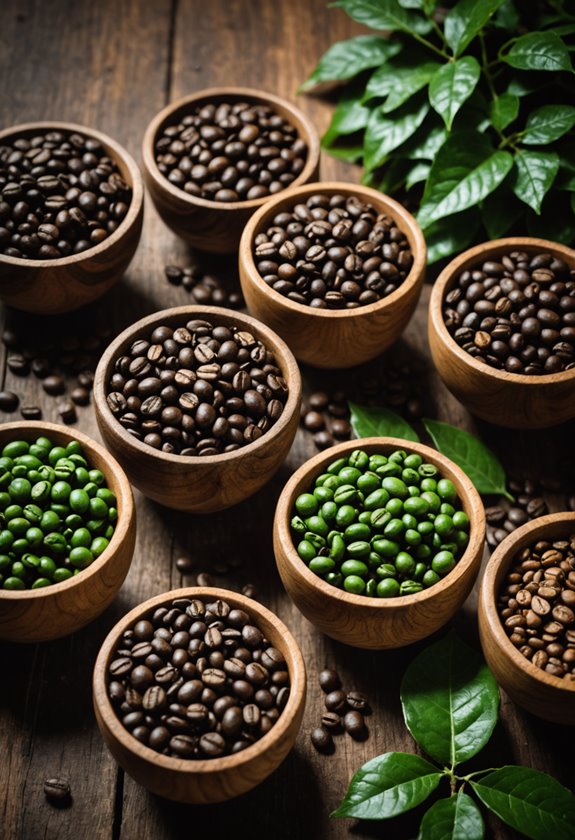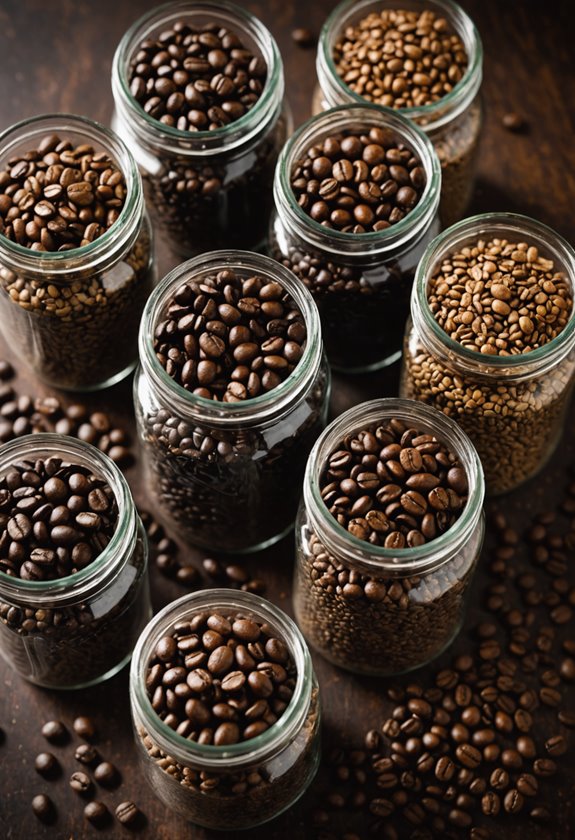How to Make Ground Coffee From Beans?
To make ground coffee from beans, start by choosing fresh, aromatic beans—Arabica for a smooth taste or Robusta for bold flavor. Light roasts maintain fruity, floral notes. Next, consider your tools: a burr grinder guarantees consistent grind size, essential for flavor extraction, while a mortar and pestle gives precise control for small batches. Your grind size depends on your brew method; coarse for French press and fine for espresso. Store ground coffee in an airtight container away from light and heat, using it within two weeks. Let's investigate these steps further to enhance your home coffee-making experience.
Key Takeaways
- Select freshly roasted coffee beans from local roasters for optimal flavor.
- Use a burr grinder for consistent grind size and enhanced flavor extraction.
- Choose the grind size based on your brewing method, such as coarse for French press or fine for espresso.
- Store ground coffee in an airtight container at room temperature to maintain freshness.
- Consume ground coffee within 2-4 weeks for maximum flavor.
Choosing Your Coffee Beans

Selecting the right coffee beans is vital for making delicious ground coffee. You should always choose freshly roasted coffee beans from local roasters or specialty shops for the best flavor and quality.
Let's examine how different bean types and roast levels affect your coffee's taste.
Bean Types and Flavor Profiles
When choosing beans, consider Arabica for a smoother, more intricate taste or Robusta if you prefer a stronger, bolder flavor.
Arabica beans often have a delicate balance of sweetness and acidity, making them ideal for those who appreciate subtlety. Robusta beans, on the other hand, are known for their intensity and earthy notes, offering a more sturdy experience.
Roast Levels and Freshness
Pay attention to the roast levels. Light roasts preserve more of the original flavor characteristics of the bean, including fruity and floral notes.
Dark roasts, however, develop a richer, bolder taste due to the longer roasting process, often with a hint of smokiness.
Checking the roast date is essential; for best freshness, consume your coffee beans within 2-4 weeks after opening. This guarantees your coffee retains its lively flavors and aromas.
Choosing the right coffee beans involves understanding these elements, allowing you to tailor your coffee experience to your unique preferences.
Oneforall Blends provide an excellent starting point for those seeking versatility in their coffee selection.
Grinding Techniques and Tools
Grinding coffee beans is an essential step in crafting the perfect cup of coffee, as it directly impacts flavor and aroma.
Let's investigate various techniques and tools available for grinding coffee beans.
Mortar and Pestle
Using a Mortar and Pestle is a traditional method that gives you precise control over grind size. It's perfect for small batches and guarantees freshly ground coffee, but it can be time-consuming.
Blade Grinder
A Blade Grinder, often found in households, uses rotating blades to chop beans. While it's affordable and compact, it may result in uneven coffee grounds, affecting the flavor profile.
Burr Grinder
A Burr Grinder is considered the best for consistent grind size. It uses two abrasive surfaces to crush the beans, enhancing flavor extraction and providing a superior coffee experience.
Electric Grinder and Blender Technique****
An Electric Grinder provides convenience and speed. If you're using a blender, try the Blender Technique: use short bursts and tilt the container for an even grind.
However, be cautious to avoid overheating the beans.
Grinding Freshness
The right grinder can make a significant difference in your daily coffee routine, with 18 grind settings available on some models like the Cuisinart for achieving the perfect texture.
Understanding Grind Sizes

Grind size is essential in revealing the full potential of your whole coffee beans. When you grind your beans, you're preparing them for different brewing methods, each requiring a specific grind size for ideal flavor extraction.
Coarse grinds are perfect for a French press, where longer contact with water reduces bitterness and enhances the smoothness of your brew. In contrast, espresso machines or Moka pots demand a fine grind, which allows for a quicker extraction and a richer, more intense flavor.
Let's investigate why a consistent grind is vital. When grinding, achieving uniformity guarantees that all grounds extract evenly. If some particles are too fine while others are coarse, you'll end up with an imbalanced brew—some parts over-extracted, others under-extracted. This inconsistency can result in a coffee that's too bitter or too sour.
Adjusting grind size based on your taste preferences is key. If your coffee tastes sour, try a finer grind; if it's too bitter, a coarser grind might be your solution.
Modern conical burr grinders provide superior consistency compared to traditional blade grinders, ensuring optimal extraction for your preferred brewing method.
Storing Ground Coffee
When it comes to storing ground coffee, timing and environment are everything. Once you've altered beans into ground coffee, its freshness starts to fade fast. To preserve that rich flavor you love, grind only what you need just before you brew.
Let's investigate how to store your coffee to maintain its peak quality.
First, use an airtight container to keep your ground coffee safe from oxidation. Exposure to air can quickly deteriorate flavor, so sealing it tight is vital.
Next, choose a cool, dark place to store your coffee. Light and heat can rob your coffee of its freshness, leaving you with a less-than-perfect brew.
While it might seem tempting, avoid refrigerating or freezing your ground coffee. Moisture from these environments can lead to a stale taste, reducing the quality of your brew. Instead, keep your coffee at room temperature, where it's safe from moisture.
Finally, remember that ground coffee is best consumed within 2-4 weeks after opening to guarantee maximum flavor and quality.
Understanding proper storage is crucial since whole coffee beans maintain their freshness significantly longer than pre-ground coffee.







